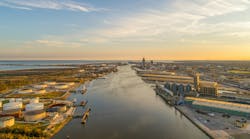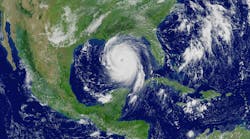Providing stormwater permit compliance services has its everyday challenges. These range from dealing with changing site conditions, changes to Storm Water Pollution Prevention Plans (SWPPPs), incorporating changes or maintaining best management practices (BMPs), or dealing with regulatory changes and reporting requirements that might impact one’s operations and budgets. They all have their unique requirements and the permits, and the science associated with them are always evolving. There is one common theme that all stormwater industry personnel from field staff to managers of municipal, industrial, and construction general permit projects can count on: it will rain again, and stormwater will runoff and have the potential to carry pollutants downstream that will need to be managed. However, no one could have imagined having to deal with the global wrench-in-the-spokes stopping that the COVID-19 pandemic has presented.
As this article is being written—and after being in lockdown for several months under work from home orders, learning new technology skills, and seeing essential businesses modifying their operations—society is beginning to open up non-essential businesses, even as COVID-19 cases are increasing in many states. It is not a pretty picture, and we have a long way to go to get back to any sense of normalcy. Businesses and business managers need to stay diligent about following good practices to avoid problems down the road. This is much like implementing BMPs to prevent downstream pollution from rain events—they only work if the procedures are followed and the BMPs are maintained.
Most people working in the environmental industry know about risks associated with environmental hazards and personal protective equipment (PPE) needed to prevent risks to individual safety, good hygiene, and sample cross-contamination. Knowing this makes those in the environmental industry slightly more aware of our surroundings and how to protect ourselves and our workers from getting ill or from contaminating samples or work environments. A good example is preparing to sample for asbestos or for bacterial DNA in beach water quality samples. This experience makes us more aware of the potential for spreading COVID-19. On the other hand, the general population may not be quite as adept at knowing why we are wearing masks, taking temperatures, and wiping nearly everything down every time someone touches something, even as this becomes our new normal.
The US Environmental Protection Agency (EPA) and many state environmental regulatory agencies recognized that with COVID-19, permit compliance might go by the wayside and issued clear guidance to permit holders that monitoring and reporting efforts are still required. The only way permittees can reduce their efforts is by providing a written justification as to why any permit requirements could be halted, delayed, or modified. Without express written consent, permit holders run the risk of violations or monetary penalties for non-compliance.
On March 26, 2020, EPA provided a Memo entitled “COVID-19 Implications for EPA’s Enforcement and Compliance Assurance Program.” The document stipulated two main points in the general conditions. All enforcement discretion set forth in the temporary policy was conditioned on the following:
- Entities should make every effort to comply with their environmental compliance obligations.
- If compliance is not reasonably practicable, facilities with environmental compliance obligations should:
a. Act responsibly under the circumstances in order to minimize the effects and duration of any noncompliance caused by COVID-19;
b. Identify the specific nature and dates of the noncompliance;
c. Identify how COVID-19 was the cause of the noncompliance, and the decisions and actions taken in response, including best efforts to comply and steps taken to come into compliance at the earliest opportunity;
d. Return to compliance as soon as possible; and
e. Document the information, action, or condition a specified in a. through d.
EPA also provided guidance for the following:
- Routine compliance monitoring and reporting by regulated entities
- Settlement agreement and consent decree reporting obligations and milestones
- For facility operations, the EPA expects all regulated entities to continue to manage and operate their facilities in a manner that is safe and that protects the public and the environment.
- Public water systems regulated under the Safe Drinking Water Act; and Critical infrastructure
Further, the EPA clarified expectations for states, writing that they “should consider the safety and health of their inspectors and facility personnel and use discretion when making decisions to conduct routine inspections, notwithstanding any applicable compliance monitoring strategy.” EPA will continue to conduct enforcement and “would focus its resources largely on situations that may create an acute risk or imminent threat to public health or the environment, to ensure protection against such risks or threats.” Lastly, EPA stated nothing in the policy “relieves any entity from the responsibility to prevent, respond to, or report accidental releases of oil, hazardous substances, hazardous chemicals, hazardous waste, and other pollutants, as required by federal law, or should be read as a willingness to exercise enforcement discretion in the wake of such a release.”
Many state entities such as California’s State Water Resources Control Board (SWRCB) and the nine Regional Water Quality Control Boards (RWQCB) issued several notices and emails to permittees that compliance with essential Permit conditions is still expected (SWRCB, 2020). It should be noted that RWQCB staff have been conducting drive-by or spot inspections to verify that permitted facilities, construction sites, and municipal activities are still complying with Permit requirements. Additionally, with RWQCB staff working remotely, there has been an enhanced focus on performing reviews of electronic database submittals. California uses the Stormwater Multiple Application and Report Tracking System (SMARTS) to provide publicly available and transparent regulatory data. Many RWQCBs are sending out reminder emails to ensure data is being reported in a timely manner and in accordance with permit requirements.
Permit managers, Legally Responsible Persons (LRPs), Duly Authorized Representatives (DARs), and Pollution Prevention Team Members (PPTs), all need to recognize that stormwater permit requirements and standard provisions are mostly still intact and required. This means that routine inspections still need to be conducted, BMPs still need to be implemented and maintained, training still needs to be conducted, and sampling, reporting, and record keeping are still required. It just might take a bit more effort under the new normal to implement these procedures. Technology has improved to the point where some operations have become more common. The use of tough books to avoid paper handling; the use of meeting applications such as Zoom, Microsoft Teams, or Skype; and the use of GoTo Webinar to conduct training have all been used to overcome many of the remote work challenge environments.
We have been seeing many clients continue to operate with modified conditions. The most common practices are to employ the five-tiered NIOSH safety approach which includes elimination (working from home or remotely, preventing access to certain areas), substitution (changing a practice to prevent worker risk), engineering controls (barriers, thermometers, and sanitizers), administrative controls (written procedures and protocols), and lastly, the use of personal protective equipment (everyone should be wearing a mask, gloves when needed, and hand sanitizer or wash stations should be readily available).
We all recognize that activities and accidents that generate pollution can happen. The biggest challenge that facility and permit managers will face will be to ensure they have staff available to do the job; with COVID-19 still looming, the safety of all staff is the main concern. With municipal budgets and supply chains in the still yet-to-be-determined phase, planning and adaptation will be the skills most needed to ensure operations continue and permit compliance is maintained. However, as previously mentioned, there is one thing we can all count on: it will rain again. When stormwater runs off, it has the potential to carry pollutants downstream—and those will still need to be managed.
References
Bodine, Susan Parker. Memorandum to All Governmental and Private Sector Partners. “COVID-19 Implications for EPA’s Enforcement and Compliance Assurance Program,” March 26, 2020. www.epa.gov/sites/production/files/2020-03/documents/oecamemooncovid19implications.pdf
California State Water Resources Control Board. “Compliance with Water Board Requirements During the Coronavirus 2019 (COVID-19) Emergency.” May 2020. www.waterboards.ca.gov/resources/covid-19_updates/index.html
Click here for Stormwater's ongoing coverage of COVID-19








